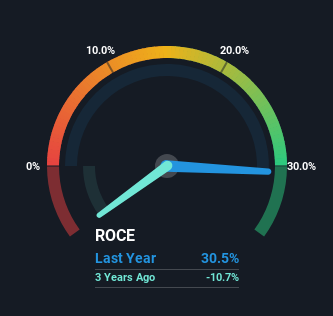Pulse Seismic (TSE:PSD) Could Become A Multi-Bagger
If you're looking for a multi-bagger, there's a few things to keep an eye out for. One common approach is to try and find a company with returns on capital employed (ROCE) that are increasing, in conjunction with a growing amount of capital employed. Ultimately, this demonstrates that it's a business that is reinvesting profits at increasing rates of return. So when we looked at the ROCE trend of Pulse Seismic (TSE:PSD) we really liked what we saw.
What Is Return On Capital Employed (ROCE)?
For those who don't know, ROCE is a measure of a company's yearly pre-tax profit (its return), relative to the capital employed in the business. The formula for this calculation on Pulse Seismic is:
Return on Capital Employed = Earnings Before Interest and Tax (EBIT) ÷ (Total Assets - Current Liabilities)
0.31 = CA$8.8m ÷ (CA$35m - CA$6.0m) (Based on the trailing twelve months to September 2023).
Therefore, Pulse Seismic has an ROCE of 31%. In absolute terms that's a great return and it's even better than the Energy Services industry average of 13%.
View our latest analysis for Pulse Seismic
While the past is not representative of the future, it can be helpful to know how a company has performed historically, which is why we have this chart above. If you're interested in investigating Pulse Seismic's past further, check out this free graph of past earnings, revenue and cash flow.
What Can We Tell From Pulse Seismic's ROCE Trend?
Like most people, we're pleased that Pulse Seismic is now generating some pretax earnings. The company was generating losses five years ago, but now it's turned around, earning 31% which is no doubt a relief for some early shareholders. Additionally, the business is utilizing 21% less capital than it was five years ago, and taken at face value, that can mean the company needs less funds at work to get a return. Pulse Seismic could be selling under-performing assets since the ROCE is improving.
For the record though, there was a noticeable increase in the company's current liabilities over the period, so we would attribute some of the ROCE growth to that. Effectively this means that suppliers or short-term creditors are now funding 17% of the business, which is more than it was five years ago. It's worth keeping an eye on this because as the percentage of current liabilities to total assets increases, some aspects of risk also increase.
The Bottom Line On Pulse Seismic's ROCE
From what we've seen above, Pulse Seismic has managed to increase it's returns on capital all the while reducing it's capital base. Since the total return from the stock has been almost flat over the last five years, there might be an opportunity here if the valuation looks good. That being the case, research into the company's current valuation metrics and future prospects seems fitting.
Pulse Seismic does have some risks though, and we've spotted 2 warning signs for Pulse Seismic that you might be interested in.
If you'd like to see other companies earning high returns, check out our free list of companies earning high returns with solid balance sheets here.
Have feedback on this article? Concerned about the content? Get in touch with us directly. Alternatively, email editorial-team (at) simplywallst.com.
This article by Simply Wall St is general in nature. We provide commentary based on historical data and analyst forecasts only using an unbiased methodology and our articles are not intended to be financial advice. It does not constitute a recommendation to buy or sell any stock, and does not take account of your objectives, or your financial situation. We aim to bring you long-term focused analysis driven by fundamental data. Note that our analysis may not factor in the latest price-sensitive company announcements or qualitative material. Simply Wall St has no position in any stocks mentioned.

